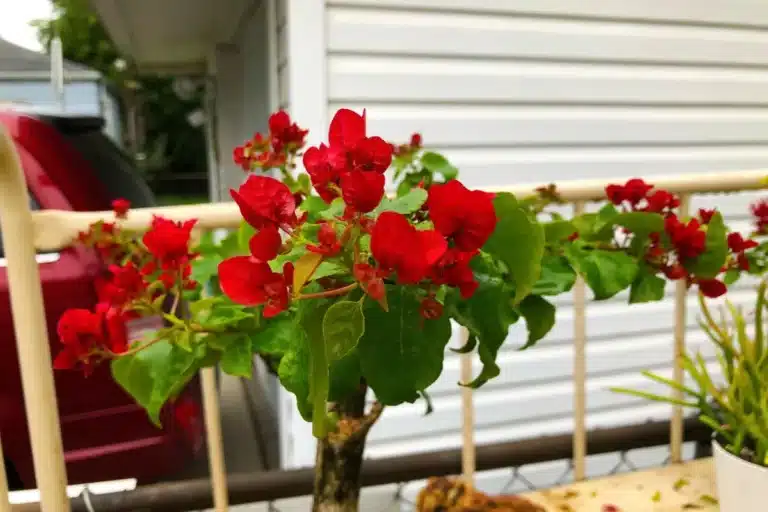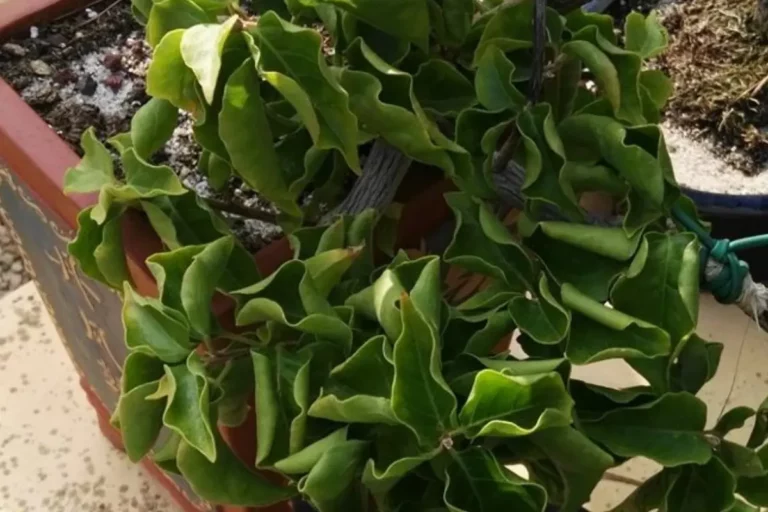Bougainvillea Bonsai – Training, Care & More
Can bougainvillea be trained into bonsai? Absolutely! Bougainvillea is widely grown for its colorful flowers, making it a great ornamental and landscaping plant. However, a different style is growing shrubby varieties of bougainvillea as bonsai trees.
To get the vine into the desired shape, you must prune and train the branches while properly caring for the bougainvillea.
Below is a complete guide on growing bougainvillea bonsai successfully. Let’s dive in!
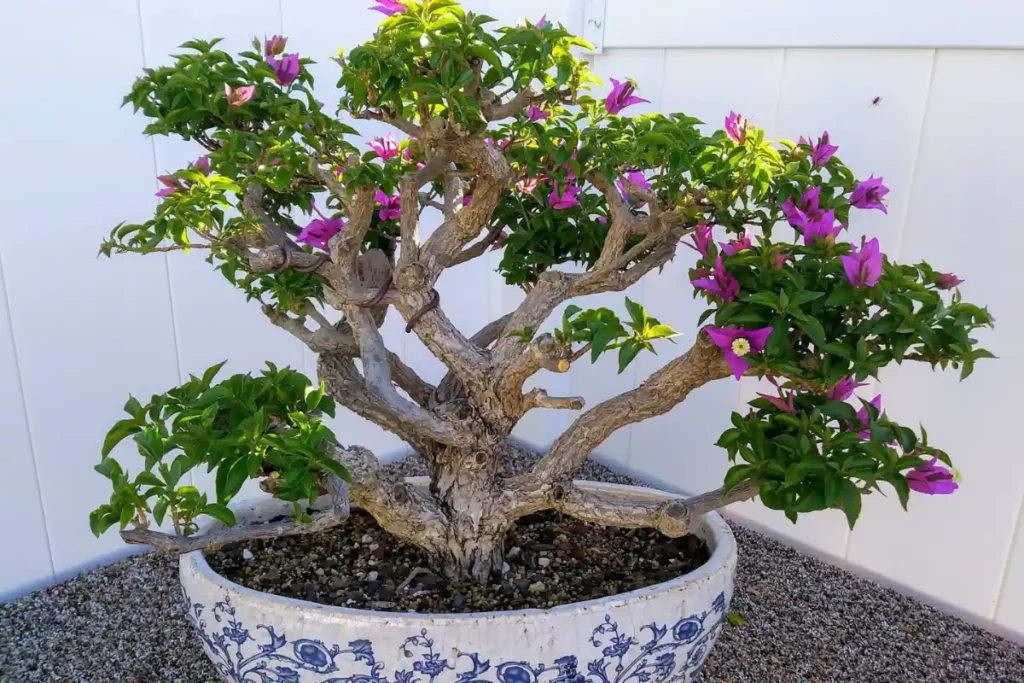
Table of Contents:
How to start a bougainvillea bonsai
Structural pruning and flower pinching are crucial in proper bougainvillea bonsai training. These practices encourage shape forming and continuous blooming. In addition, defoliation is a core part of shaping, strengthening, and encouraging the tree to branch out.
I recommend performing these tasks at the start of the growing season to take advantage of maximum growth.
Here’s how to start a bougainvillea bonsai:
1. Choose the right bougainvillea variety
You can start a bougainvillea bonsai from seed, but it is more common to start with a young plant. Bougainvillea glabra, also called the lesser bougainvillea, is the most common variety used for bonsai. Other varieties that you can train into bonsai trees include Bambino, Jalibene, Zulu, Pedro, Panda, and Zuki.
These are typically short-growing varieties with very few thorns, so handling and training them is much easier.
However, “you can start with a slightly overgrown bougainvillea bush and train it into an amazing bonsai, provided you choose a healthy plant with a strong central trunk,” advises Robert Sanford, a specialist in bonsai and tropicals.
2. Prune the plant to remove large leaves
Prune the plant, removing large leaves and extra-long vines to shape it and encourage new growth. Cut off any branches growing in undesirable directions for your bougainvillea bonsai tree.
Also, cut back any dead, diseased, or damaged branches.
For the best results, prune the bougainvillea bonsai at least once monthly during the growing season. The goal is to shape the plant vertically with a trunk at the center or into a horizontal shape. Meanwhile, avoid pruning your bougainvillea during winter dormancy.
3. Wire the branches
Wiring the bougainvillea is the most important step to achieving a bonsai out of it, as it trains and controls the growth pattern of the plant.
Gently tie and twist a soft wire around the branches in a spiral manner to make it easy to train the plant in any shape and direction.
When training bonsai bougainvillea by wiring, leave the wires in place for at least a couple of weeks before taking them out to see if the branches have assumed the desired form and shape.
Wiring is best applied on newer shoots. Older branches easily break when tied with wires and forced to assume a new shape,
You can also train bougainvillea bonsai using weights or clips. This method is less common but is just as effective. Small weights, such as pebbles, are tied to the branches, gradually bending them into a natural curve.
4. Prepare a fresh soil mix for repotting
Bougainvilleas prefer well-draining soil that is rich in organic matter. You can make your own potting medium by mixing potting soil, perlite, peat moss, and pine bark in equal parts. Alternatively, buy a ready-to-use commercial bonsai soil mix (like this one from Amazon).
5. Repot the plant
The next step is to repot the plant into a container that’s slightly larger than the current pot. Choose a pot with drainage holes at the bottom.
Remember, bougainvilleas need full sun to flower, so place your bonsai in a spot that gets at least 6 hours of direct sunlight daily.
6. Overwinter the bougainvillea
If you live in a cold climate, it is advisable to overwinter your bougainvillea bonsai indoors. Place the plant in a cool, bright location away from cold drafts to protect it from cold damage.
Gardener’s note: Always start with a young bougainvillea plant. It is easier to shape it than a mature plant. In addition, be patient because potted bougainvillea are slow-growers and may take time to develop into properly-shaped bonsai.
Video
Care for bougainvillea bonsai
Success with bougainvillea means providing near-native growing conditions.
According to Steven Sullivan, Editor of Plantnative, “Bougainvillea is treasured for its drought tolerance, low maintenance, and its tendency to cover fences, walls, and pergolas, providing a beautiful display of colors.” Not all these attributes can be achieved with bonsai, but a burst of colorful blooms can happen with meticulous care and training.
Here are expert care guidelines for bougainvillea bonsai:
| Potting mix | It requires a well-draining, nutrient-rich potting mix |
| Soil pH | 6 to 6.5 |
| Water | Water 1-2 times per week |
| Placement | Sunny spot |
| Lighting | Full sunlight |
| Humidity | 50-60% |
| Temperature | Tolerant; 60°F to 100°F |
| Pruning | Monthly pruning for training |
| Fertilizer | Regular during the growing season |
| Repotting | Every 2-3 years. |
Potting and repotting
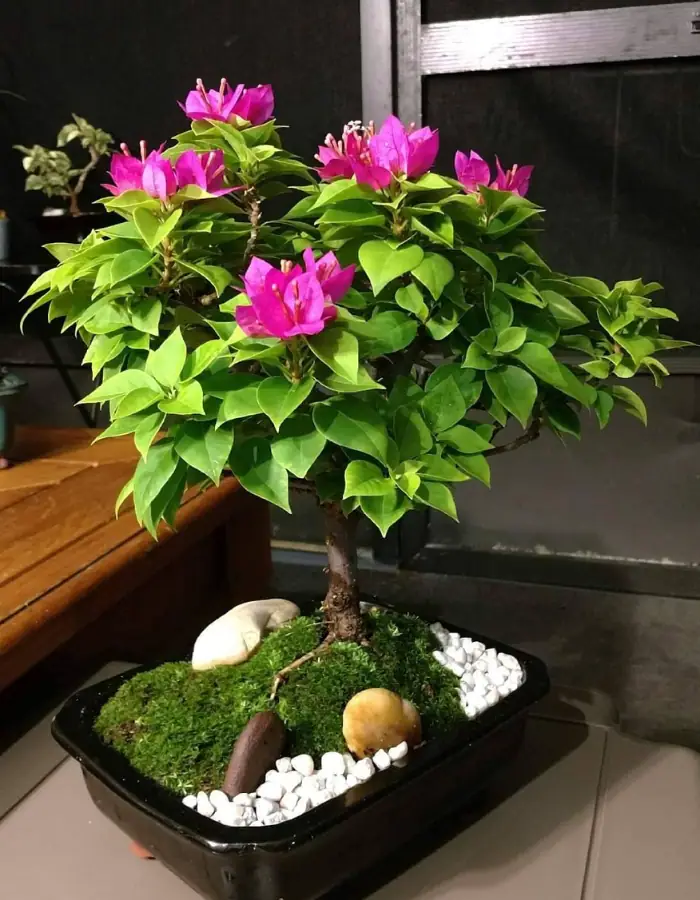
Bonsai bougainvillea prefers well-draining soil that allows optimal moisture intake with a moderate water retention rate. The soil mix should also be nutrient-rich to promote growth and blooming.
Repot the bonsai every 2-3 years, preferably in late spring. I prefer to water my bougainvillea at least two days before repotting so that the soil dries out before the procedure. This way, the chances of killing the plant are minimal.
Be careful not to damage the roots of your plant when repotting. Bougainvillea bonsai roots are usually thin and delicate and can break easily when disturbed.
Shock is an expected reaction after potting and repotting. A few leaves might fall off during that transition, but they’ll grow back since the bougainvillea is in rapid development during this time.
Potting soil and container
The best soil mix should contain a balanced mix of garden soil, sand, perlite, pine bark, pumice, and compost. Bonsai bougainvillea flourishes in soil containing at least 40% organic matter.
The lateral spread of the roots should help you determine the size of the pot. Use a bigger pot to reserve space for downward root growth.
Since plants are trained to be bonsai for aesthetic reasons, you can go for a pot whose color contrasts that of the bougainvillea’s bracts for added ornamental appeal.
Finally, ensure the pot has drainage holes to avoid waterlogging that can stress and stunt the plant.
Water
Bougainvillea bonsai plants don’t like wet roots, which leads to root rot and will likely kill the plant. They prefer slightly dry soil, but not too dry.
The best way to water this plant is once the top inch of the soil dries up. Ideally, it would be best to irrigate bonsai bougainvillea once or twice weekly.
Placement
If you’ve bought a very young bougainvillea plant from your local nursery and are looking to train it into a bonsai, it’s best to plant it directly in garden soil before potting it later. Young bougainvillea has thin, brittle roots that can easily break during potting.
Once the roots are sturdy enough to withstand relocation, you can repot the bonsai bougainvillea. Remember that repotting is best done in late spring, at the peak of the bougainvillea’s growing season.
Also, when growing bougainvillea bonsai, it’s better to have a thick trunk. Planting in garden soil allows the roots to grow laterally, promoting the development of a thicker trunk. Growing bougainvillea bonsai in a pot from the start results in a thinner trunk due to the roots being laterally confined.
Light
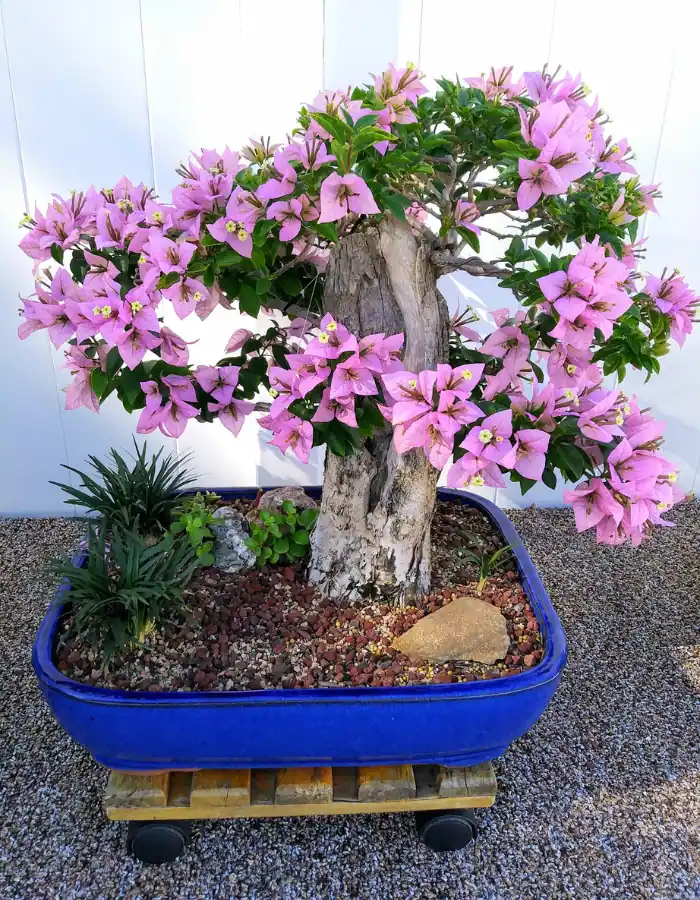
Bougainvillea plants flourish in bright, direct sunlight. You should, therefore, expose your bougainvillea bonsai to at least 6 hours of uninterrupted sunlight per day.
Low light conditions lead to reduced leaf production in bougainvillea. This isn’t appropriate for bonsai bougainvillea, which requires dense foliage to complete its aesthetic effect.
If your potted bonsai bougainvillea isn’t receiving enough sunlight indoors, consider moving it close to a south-facing window that receives lots of sunlight. Alternatively, you can use indoor grow lights or move the plant outdoors where it can receive full, direct sunlight.
Humidity
Bougainvillea will flourish if the humidity is high. Therefore, keep the relative humidity around the plant at 50% or higher.
Invest in a humidity tracker to know when the humidity levels drop below optimal conditions.
You can then raise the relative humidity using a room humidifier.
Temperature
Bonsai bougainvillea is vulnerable to frosty conditions and should be kept indoors whenever temperatures drop below 40 degrees Fahrenheit. Temperatures should be at least 50 degrees Fahrenheit during pruning. It reduces the chances of frost and shock from temperature changes.
Pruning and pinching
Bougainvillea bonsai can tolerate heavy pruning as new buds develop, even on old, pruned shoots.
There are two levels of pruning for bonsai bougainvillea:
- Structural pruning should be done in late winter or early spring. It involves removing entire branches to shape the plant. The timing of structural pruning is vital. Premature pruning will leave the plant open to frost. Late structural pruning can harm budding flowers that might not bloom until the next bloom season.
- Maintenance pruning is a gentler form of pruning done during active growth in the season. It’s specifically for beauty purposes.
Flower pinching might be necessary if you notice dead flowers. Removing dead leaves and flowers encourages faster regrowth, which helps in shaping the bonsai.
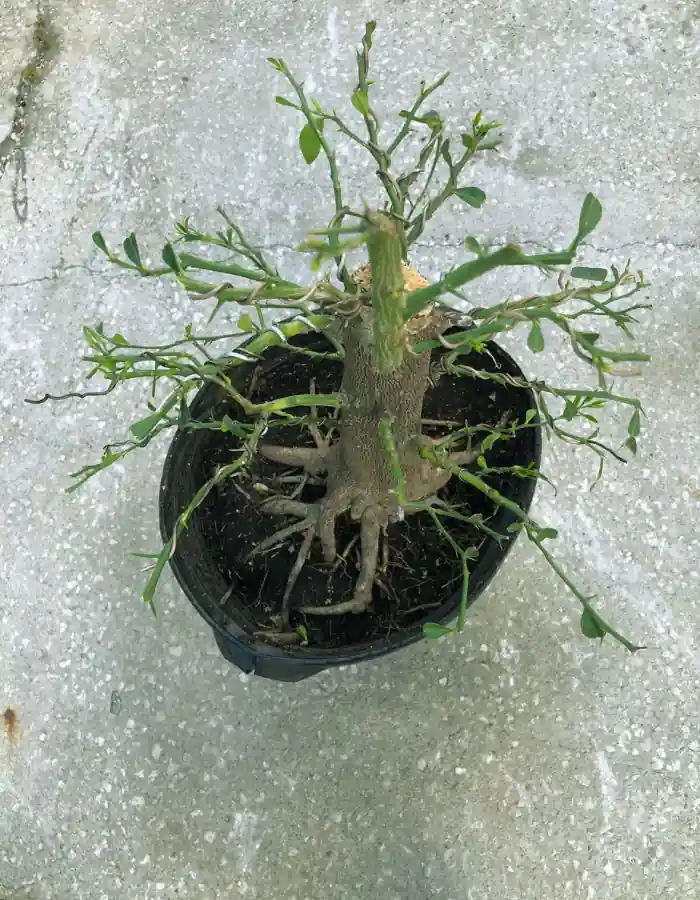
Dense Seghesio Levine, a University of California Master Gardener, Napa County, recommends that you “prune and pinch after the flowering cycle has completed. The more you pinch, the more your bougainvillea will branch and bloom.”
When pruning bonsai bougainvillea, wear protective hand gloves to protect yourself from the plant’s thorns. Bougainvilleas get a lot of thorns when left in the ground, but if properly cared for, they can be thornless and safe for indoor use.
Fertilizer
Bonsai bougainvillea flourishes more when fed with fertilizer during the growing season. The recommended fertilizer NPK ratio and frequency for plants in this genus is 12-10-10 once every 14 days.
Also, you can use a 2-10-10 in winter. Using Nitrogen-rich fertilizer stimulates leaf growth.
FAQ
How long does it take to make a bougainvillea bonsai?
It can take anywhere from a few months to several years to develop a beautiful bougainvillea bonsai depending on your skill level and the size of the plant you start with. If you start with a young plant, you will need to be patient as it grows and develops. You must also be diligent about pruning and wiring the plant to create the desired shape.
How long do bougainvillea bonsai live?
Bougainvillea bonsai can live approximately 10 to 30 years or more with proper care, including regular pruning, adequate sunlight, proper watering, and repotting in rejuvenated, well-draining soil. Expert attention may extend their lifespan further, while neglect can shorten it.
Can bougainvillea bonsai grow indoors?
Bougainvillea bonsai can be kept indoors for a limited period, but their long-term vitality may be compromised compared to those kept outdoors year-round. You’d rather try shade-tolerant indoor plant species, such as ficus. Even with these species, providing supplemental lighting with strong grow lights may be required to enhance their well-being and growth.
Conclusion
Growing a bonsai can be a little more challenging, but they are pretty much like keeping any potted plant once you figure out their care needs.
You can train your bougainvillea into a bonsai by pruning it into the proper shape and size for bonsai trees. It can be hard to train tall, vining bougainvillea into a bonsai. Therefore, it’s better to go for low-growing, shrubby bougainvillea varieties instead.


